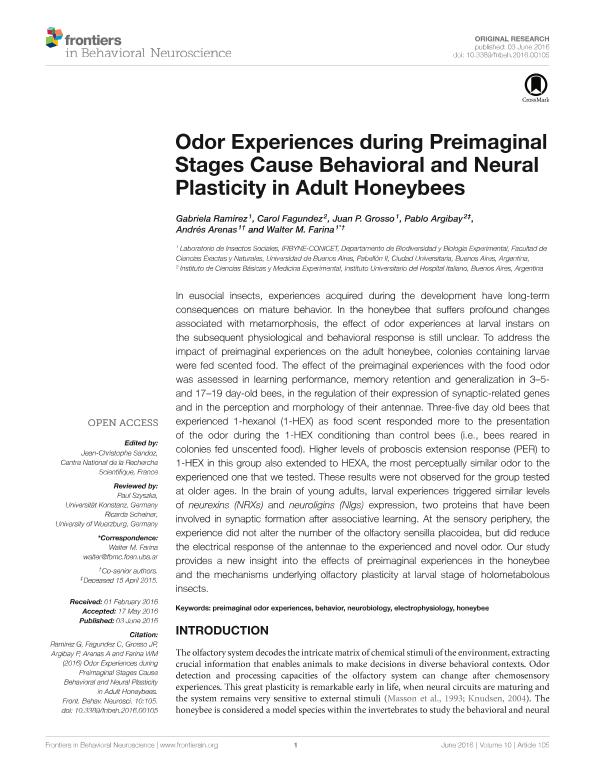Mostrar el registro sencillo del ítem
dc.contributor.author
Ramirez, Gabriela Paola

dc.contributor.author
Fagundez, Carol Betiana

dc.contributor.author
Grosso, Juan Pedro

dc.contributor.author
Argibay, Pablo Francisco
dc.contributor.author
Arenas, Andres

dc.contributor.author
Farina, Walter Marcelo

dc.date.available
2020-08-25T21:39:02Z
dc.date.issued
2016-06
dc.identifier.citation
Ramirez, Gabriela Paola; Fagundez, Carol Betiana; Grosso, Juan Pedro; Argibay, Pablo Francisco; Arenas, Andres; et al.; Odor experiences during preimaginal stages cause behavioral and neural plasticity in adult honeybees; Frontiers Media S.A.; Frontiers in Behavioral Neuroscience; 10; 105; 6-2016; 1-14
dc.identifier.issn
1662-5153
dc.identifier.uri
http://hdl.handle.net/11336/112413
dc.description.abstract
In eusocial insects, experiences acquired during the development have long-term consequences on mature behavior. In the honeybee that suffers profound changes associated with metamorphosis, the effect of odor experiences at larval instars on the subsequent physiological and behavioral response is still unclear. To address the impact of preimaginal experiences on the adult honeybee, colonies containing larvae were fed scented food. The effect of the preimaginal experiences with the food odor was assessed in learning performance, memory retention and generalization in 3–5- and 17–19 day-old bees, in the regulation of their expression of synaptic-related genes and in the perception and morphology of their antennae. Three-five day old bees that experienced 1-hexanol (1-HEX) as food scent responded more to the presentation of the odor during the 1-HEX conditioning than control bees (i.e., bees reared in colonies fed unscented food). Higher levels of proboscis extension response (PER) to 1-HEX in this group also extended to HEXA, the most perceptually similar odor to the experienced one that we tested. These results were not observed for the group tested at older ages. In the brain of young adults, larval experiences triggered similar levels of neurexins (NRXs) and neuroligins (Nlgs) expression, two proteins that have been involved in synaptic formation after associative learning. At the sensory periphery, the experience did not alter the number of the olfactory sensilla placoidea, but did reduce the electrical response of the antennae to the experienced and novel odor. Our study provides a new insight into the effects of preimaginal experiences in the honeybee and the mechanisms underlying olfactory plasticity at larval stage of holometabolous insects.
dc.format
application/pdf
dc.language.iso
eng
dc.publisher
Frontiers Media S.A.

dc.rights
info:eu-repo/semantics/openAccess
dc.rights.uri
https://creativecommons.org/licenses/by/2.5/ar/
dc.subject
Honeybee
dc.subject
Olfactory learning
dc.subject
Holometabolous insect
dc.subject
early experience
dc.subject
Plasticity and Learning
dc.subject.classification
Zoología, Ornitología, Entomología, Etología

dc.subject.classification
Ciencias Biológicas

dc.subject.classification
CIENCIAS NATURALES Y EXACTAS

dc.title
Odor experiences during preimaginal stages cause behavioral and neural plasticity in adult honeybees
dc.type
info:eu-repo/semantics/article
dc.type
info:ar-repo/semantics/artículo
dc.type
info:eu-repo/semantics/publishedVersion
dc.date.updated
2020-07-01T17:04:20Z
dc.journal.volume
10
dc.journal.number
105
dc.journal.pagination
1-14
dc.journal.pais
Portugal

dc.description.fil
Fil: Ramirez, Gabriela Paola. Consejo Nacional de Investigaciones Científicas y Técnicas. Oficina de Coordinación Administrativa Ciudad Universitaria. Instituto de Fisiología, Biología Molecular y Neurociencias. Universidad de Buenos Aires. Facultad de Ciencias Exactas y Naturales. Instituto de Fisiología, Biología Molecular y Neurociencias; Argentina
dc.description.fil
Fil: Fagundez, Carol Betiana. Instituto Universitario del Hospital Italiano; Argentina
dc.description.fil
Fil: Grosso, Juan Pedro. Consejo Nacional de Investigaciones Científicas y Técnicas. Oficina de Coordinación Administrativa Ciudad Universitaria. Instituto de Fisiología, Biología Molecular y Neurociencias. Universidad de Buenos Aires. Facultad de Ciencias Exactas y Naturales. Instituto de Fisiología, Biología Molecular y Neurociencias; Argentina
dc.description.fil
Fil: Argibay, Pablo Francisco. Hospital Italiano. Instituto de Ciencias Básicas y Medicina Experimental; Argentina
dc.description.fil
Fil: Arenas, Andres. Consejo Nacional de Investigaciones Científicas y Técnicas. Oficina de Coordinación Administrativa Ciudad Universitaria. Instituto de Fisiología, Biología Molecular y Neurociencias. Universidad de Buenos Aires. Facultad de Ciencias Exactas y Naturales. Instituto de Fisiología, Biología Molecular y Neurociencias; Argentina
dc.description.fil
Fil: Farina, Walter Marcelo. Consejo Nacional de Investigaciones Científicas y Técnicas. Oficina de Coordinación Administrativa Ciudad Universitaria. Instituto de Fisiología, Biología Molecular y Neurociencias. Universidad de Buenos Aires. Facultad de Ciencias Exactas y Naturales. Instituto de Fisiología, Biología Molecular y Neurociencias; Argentina
dc.journal.title
Frontiers in Behavioral Neuroscience
dc.relation.alternativeid
info:eu-repo/semantics/altIdentifier/url/http://journal.frontiersin.org/article/10.3389/fnbeh.2016.00105/full
dc.relation.alternativeid
info:eu-repo/semantics/altIdentifier/doi/http://dx.doi.org/10.3389/fnbeh.2016.00105
Archivos asociados
